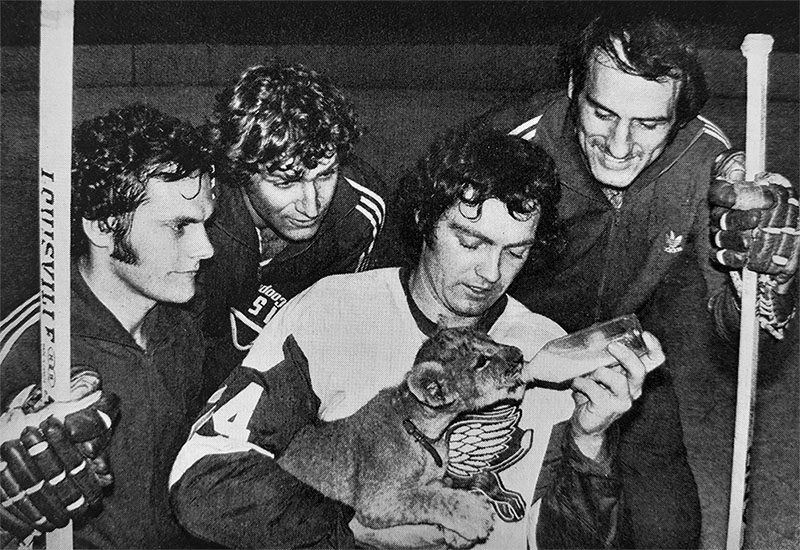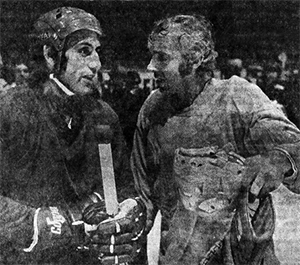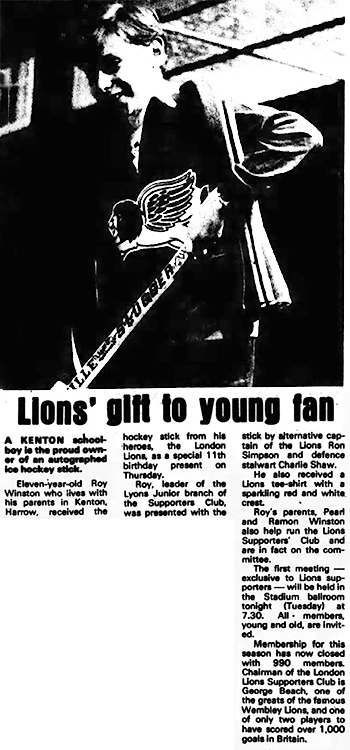
the team
|
The hockey league that never was (part 1) The team |
Brian McCutcheon, Brian Watts, Rick Newell and Rick McCann with their mascot Puck, a lion cub from the Longleat Safari and Adventure Park in southern England In December 1972, Norris and his men reported that they had booked 27 dates at the Wembley Empire Pool in London for the European league in the upcoming 1973-74 season. This was probably crucial for the decision to form the London Lions when it turned out that the league wouldn't start until October 1974. The dates were booked, so it would be financially foolish not to use them. And once a team was created to play exhibition games in London, it also made sense to let the same team tour the rest of Europe to promote the league during December, January and February when the arena was hosting an ice show. That was an annual tradition since the late 1940s when the British arenas started looking for new sources of income. It was also an easy choice to name the team the London Lions. There had been a team with that name operating from the mid-20s to the mid-30s, and its logo actually was a winged lion. This team, which comprised mainly expatriate Canadians, contested the final of the 1924-25 Coupe de Davos and made it through to the quarterfinals of the prestigious Spengler Cup. 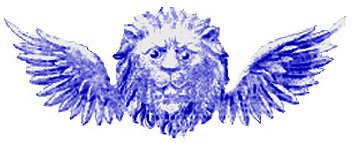  The original London Lions in December 1925 When the Empire Pool & Sports Arena opened at Wembley in 1934, one of the two hockey teams was named Wembley Lions. It's likely that their Lions nickname was chosen as a tribute to the earlier team but their logo was also reminiscent of the symbol of the large Imperial Exhibition held at Wembley back in 1924. The ice shows at Wembley and other ice hockey arenas forced the British teams to make mid-winter tours of Europe and the Wembley Lions visited Sweden several times during these years. The visit in 1951 offers an interesting trivia note: 9-year old Ulf Sterner was watching the game between his Forshaga and Wembley and got very impressed by the Anglo-Canadians. Little did he know that he would play in a similar team 22 years later. In 1959 the Wembley Lions won the Ahearne Cup played as usual in Sweden. They made their last appearance at Wembley on 30 November 1968, beating Paisley Mohawks 3-0. 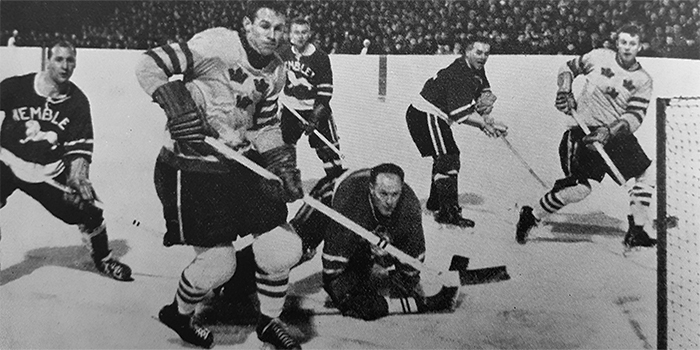 Wembley Lions in Sweden 1959 In traditional heraldry, a winged lion is the symbol of St. Mark but the iconic ice hockey version was basically a combination of the British lion of Wembley and the Red Wings of Detroit. However, there had been a large feline in the history of the Detroit Red Wings as well. The Detroit Hockey Club Incorporated was granted an NHL franchise on 25 September 1926 when the Victoria Cougars of the Western Canadian Hockey League was bought by local businessmen and reborn as the Detroit Cougars. In 1930, in an attempt to change the team's fortunes, the name was changed to the Detroit Falcons. On 5 October 1932, grain broker James Norris from Chicago bought the team and renamed it the Detroit Red Wings. Their logo was inspired by the winged wheel used by the Montreal Amateur Athletic Association, a team Norris had played for in his youth. The winged wheel is associated with the ancient Greek god Hermes and represent transport, speed and progress, a fitting symbol for a team from the Motor City. The names of Detroit's farm teams often alluded to flying - like Pittsburgh Hornets and Edmonton Flyers - and those teams often sported colours, uniforms and logos similar to the parent team in NHL, which shows that the winged lion of London followed an old tradition. Memphis was the center of the American cotton industry so it was natural that the logo of Detroit-affiliate Memphis Wings of the CHL (where future London Lion Rick McCann made his pro debute in 1966-67) was a winged cotton boll. The Kalamazoo Wings in the IHL was nicknamed the K-Wings for obvious reasons. Kelowna Wings in British Columbia joined the WHL in 1982 and Kelowna's location in Canada's leading fruit district was reflected by their winged apple. During the 80s and 90s, Detroit's primary affiliate was Adirondack Red Wings, based in Glen Falls in the Adirondack Mountains and the EHL-team Johnstown Wings in Pennsylvania developed a secondary affiliation with Detroit as a farm team of the Adirondack Red Wings, sporting a winged J. 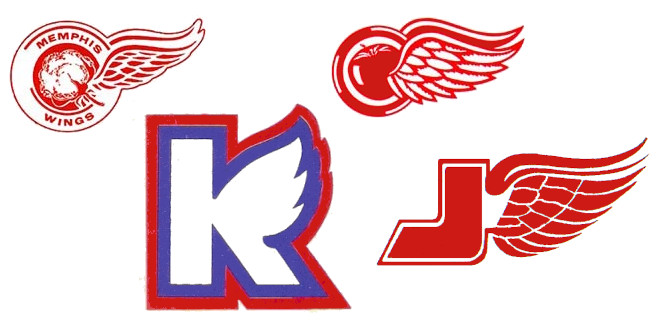 Various wings of Memphis, Kalamazoo, Kelowna and Johnstown Detroit's AHL-affiliate in Norfolk, Virginia, was in many ways the sister team of London Lions and six of the Londoners - Newell, McKenzie, Mellor, Jakubo, Korney and Richardson - also played in Virginia in 1973-74. In its first season in 1971-72, the Norfolk team had been named Tidewater Wings after the Tidewater region with its low lying swamps and wide tidal rivers but the name was changed to Virginia Wings in 1972-73 when Doug Barkley became their coach. Al Coates was their business manager and had the job of launching the Norfolk franchise. In the summer of 1973, Barkley and Coates were chosen to put the London Lions together. The team was to be a 17-man squad, consisting mainly of Canadians and possibly some Europeans. Initially, four-five Swedes or Finns or older Czechs and maybe some British players were mentioned. In mid-June 1973 it was announced that the Lions would participate in either Star Cup or Ahearne Cup in December - both tournaments held in Sweden - or even the Izvestia Tournament in Moscow. As for the 27 dates at Wembley, the Lions were scheduled for a six-week round of three matches-a-week against clubs from Czechoslovakia, Finland, West Germany, the Netherlands and - hopefully - the Soviet Union. In all, it was calculated that the Lions would play between 50 and 60 exhibition games during the season. On 5 September, Swedes Tord Lundström, Leif Holmqvist and Thommie Bergman travelled to the US to attend the training camp led by Ted Garvin at the McMarron Arena in Port Huron, Michigan, held between 10 and 15 September. Detroit Red Wings had invited 87 players to camp, but two of them were no-shows after signing with the rival WHA. There were 11 netminders, 28 defensemen and 48 forwards. 32 of them were amateurs and 55 were professionals. Besides the parent club, players would be placed with one of three farm clubs - London Lions, Virginia Wings (AHL) and Port Huron Wings (IHL). Ulf Sterner was probably the only player in the London Lions who had the intention to be professional in Europe. He still belonged to the New York Rangers and first went to their training camp in Kitchener. They offered him a place in the Providence Reds in AHL but he chose the London Lions instead and the Rangers lent him to the Red Wings specifically to play in London. Doug Barkley added promising juniors with routine players he had coached recently. Six of the future Lions - McCann, McCutcheon, Watts, Shaw, Newell and Simpson - had played for Barkley in various combinations in 1971-72 and 1972-73 for winged teams in Fort Worth (CHL), Norfolk (AHL) and Port Huron (IHL). Fran Huck and Danny O'Shea, well-known in Europe after playing for Canada in recent Olympics and World Championships, were mentioned in European media as possible Lions despite not attending the camp. Media reported that two Finns had been offered a contract but this may have been a garbled reference to Sterner and Holmqvist since no Finns were invited to the training camp. The other two Swedes, Lundström and Bergman, were destined for Detroit. There actually was a fifth Swede on the training camp, Teuvo Lindroos from Borås, but he was released from tryout and spent the rest of his career in the Swedish second and third divisions. When all players for the Lions had been chosen and some intrasquad games against the Virginia Wings had been played, the London team played their first real game in the Detroit Olympia arena against the Toledo Hornets on 11 October. One of the last additions to the team was Terry Clancy, who was traded from Toronto to Detroit on 17 October 1973. Home for the players in London was the Esso Motor Hotel, just a stone's throw from Wembley Stadium, a hotel where just about everybody who came to that venue - athletes, musicians - stayed. London Lions were supported by IIHF president Bunny Ahearne and thus registered as amateurs by the British Icehockey Association, which meant that they were able to play against teams from Scandinavia and eastern Europe. London Lions' season wasn't as random and haphazard as sometimes has been suggested. Their very long roadtrip was born out of necessity since their home arena in London wasn't available for three months, from December 1973 to February 1974. So, their home games were spread out over nine weekends in October, November and March which meant two or three games each weekend versus the same opponent. Seemingly there was the intention to meet these opponents away as well. The BBC covered some of the games on television. The Lions had the ambition to develop British hockey and according to Howard Bass in the Evening Standard on 22 October, the Lions would train twice a week at Streatham Ice Arena in south London. They were also scouting the British League's 17 amateur teams but Barkely said that he thought it would be three to five years before any British players were good enough to earn a place in the team. The games in Scotland and North East England in early December were likely arranged to see if any of these players would fit in the proposed league. One British player, Chris Dean, practised with the Lions in March 1974 and played against them with the Altrincham Aces in Deeside on 26 March. Dean later played in the British league with the Deeside Dragons. In late October, there were plans for a combined Frölunda/Färjestad team to play against the Lions in Gothenburg on 11 December but it turned out to be two separate games with London playing Frölunda on the 10th and Färjestad on the 11th. The Scandinavium Arena in Gothenburg was brand new at the time and considered to be excellent for the planned European league. According to statements in media, Frölunda were thus invited to London for a series but the Swedish Ice Hockey Association said no and a "Finnish team" - probably the so called Finnish Olympics - took their place. On 4 November, the participation of London Lions in Ahearne Cup in Sweden was annonunced. At the time it was said that the Lions would play twelve games in Sweden (which they did) and
thirteen in Finland (which they didn't). However, over the whole the season they did play a total
of fourteen games against
Finnish teams - six games in Finland and eight in London. It was reported that the North American TV show Hockey Night in Canada would have a feature about the Lions and the European Hockey League on 29 December. London Lions spent the holiday season in Sweden and Finland, arriving just after Saint Nicholas Day and leaving shortly after Twelfth Night. They played a total of 18 games during that time, including two on outdoor rinks. After the stint in Scandinavia, the Lions went to the Netherlands. They stayed at the Hotel Bel Air in the Hague until 27 January and trained every day at the HOKY (Hokij) arena. A unique thing with the London Lions was the presence of wives and children on the road. Nancy and Rick McCann had 3 year old daughter Mical (nicknamed Micky) and two other wives who made the trip were Janice Wing, the wife of defenceman Murray Wing, and Lotta Holmqvist, the wife of goaltender Leif Holmqvist. Their son Klas-Erik was even younger than Mical - born in July 1973 - so Lotta and Klas-Erik occasionally went home to Sweden for a break. McCann was interviewed by Pat Mooney for an article published in the Harrow Observer 16 April 1974, where he said that the last weeks of the road trip were not organised properly and that the players were beginning to feel the strain of having played so many matches. During the stop in Czechoslovakia they were asked to stay another week and squeeze in four more games, which they did. They were supposedly back at the Hotel Bel Air in the Hague during the last week of February, but there have also been talk about some extra games played by the Lions around that time in Yugoslavia (announced before the road trip started) and France (rumoured later). Two games at the end of the road trip - against ZKL Brno in Czechoslovakia on 16 February and the
West German national team on 1 March in Germany - were abandoned due to benchclearing fights. When the 1973-74 season ended, nobody knew what would happen to the London Lions. Already in December, Barkley had said that he wanted 5-6 new players for the next season - but would there be a league to play in? |
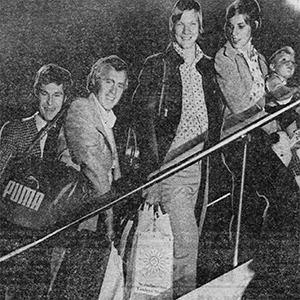 Lundström and Holmqvist flying from Sweden to the Red Wings' training camp with Thommie, Eva and Tobias Bergman in early September 1973
|
